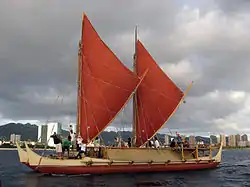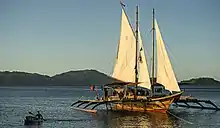Colandia
Colandia (Tamil: சொழாந்தியம்) also kolandiapha, kolandiapha onta, or kolandiaphonta[1] was a kind of vessel, which was used by Early Chola.[2][3] Chola used two varieties of vessels. The first kind, known as the Sangara, including vessels both large and small. The second variety, called Colandia, were very large in size and these types of vessels were used for voyages to the Ganges and the Chryse, which was the name of various places occurring in Ancient Greek geography. Also, the Chola had voyages from the ancient port Puhar to Pacific Islands.[4][5]
| History | |
|---|---|
Srivijaya Sailendra dynasty | |
| Name: | Colandia, kolandiapha, kolandiapha onta, kolandiaphonta |
| Builder: | Javanese people and Sumatran people |
| General characteristics | |
| Type: | Sailboat |
| Length: | More than 50 m (164 feet) |
It is now generally accepted that rather than being an Indian name for an Indian vessel kolandiaphonta was a straightforward transcription of the Chinese term Kun-lun-po, which refers to Indonesian vessel (see jong ship).[6] The Sangara is likely to have been derived from an Indonesian twin-hulled design similar to some of the multi-hulled vessels in which mariners explored much of the Pacific.[7]
See also
References
- Coedès, George (1968). The Indianized States of South-East Asia. University of Hawaii Press. ISBN 9780824803681.
- "Periplus mentions 3 ports in Tamil country of which kaveripatnam as center, as the places from which great ships which calls colondia sailed to pacific islands" - K.M.Panikkar in "geographical factors in indian history", ப-81.
- The Colandia type of vessels were employed for voyages between the Coramandel coast on the one hand and the Gangetic delta and Khryse
- Two kind of vessels
- Naval Warfare in ancient India by Prithwis Chandra Chakravarti
- J. Hornell, Memoirs of the Asiatic Society of Bengal Vol. 7 1920. Part IV p. 215 – The Classes of Vessels Employed by Indians in Ancient Days Prior to Portuguese Maritime Dominance.
- Dick-Read, Robert (July 2006). "Indonesia and Africa: questioning the origins of some of Africa's most famous icons". The Journal for Transdisciplinary Research in Southern Africa. 2: 23–45.



.jpg.webp)